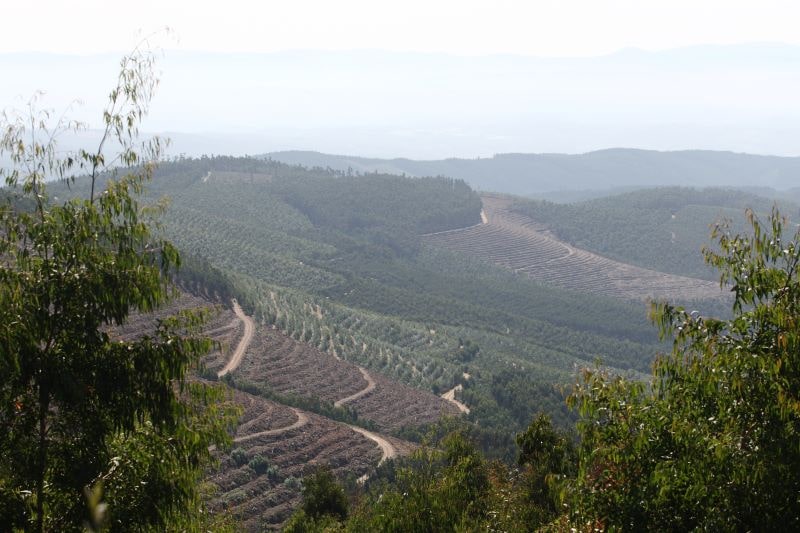Navigator has been involved since the outset in setting up the local schemes for both international certification systems, the FSC (Forest Stewardship Council) and the PEFC (Programme for the Endorsement of Forest Certification), and has invested in having all the area under its management certified under both.
This is not certification of the quality of produce (be it wood, cork or other non-ligneous forest products), but rather of the forest management procedures used in the areas from which the products are obtained.
To be certified, management has to be economically viable, environmentally sound and socially responsible.
Another essential factor in order for the end product – the paper Navigator produces – to display the seal of approval is that the entire chain of custody/responsibility is certified, ensuring traceability of all processes from the forest to the product.
Navigator obtained forest certification from the FSC in 2007 and from the PEFC in 2009, and has gradually extended the range of products which its forests can offer as certified.
Although the two certification systems originated separately from each other, they have evolved towards greater alignment of requirements, as a result of their own growth and the growing awareness in society of issues relating to sustainable development.
As a result, the requirements set in the rules of both schemes (see insert) are identical with regard to many parameters. However, there are differences in the governance system and how the rules are developed.
In the FSC (set up in 1994 on the initiative of NGOs concerned about deforestation and harmful exploitation of forests, in response essentially to developments in the southern hemisphere), the Principles and Criteria making up the central standard are the same worldwide, although each country can adapt them to a certain extent to the local situation as expressed by the indicators.
In contrast, in the PEFC (set up in Europe, in 1999, by forest producers’ organisations), the rules can vary from country to country, although they must necessarily include the pan-European standards for sustainable forest management and a set of additional requirements.
The validity periods for the certificates also differ, FSC certification has a duration of five years, and PEFC three years, but in both systems the entities certified are subject to an annual audit.
Biodiversity conservation
As awareness grows in relation to the social and environmental issues raised by forest management, certification offers society a response to expectations of this type.
Respect for and preservation of relevant natural and socio-economic assets in areas under operation is one of the most important aspects considered in certification, and in this field Navigator has developed an innovative approach, incorporating conservation issues into its forest management model and making it part of its everyday work.
In the case of biodiversity, this is an approach which responds to the commitment to ensure that the planning and execution of the company activities will at least result in no net loss in the existing biodiversity and, whenever possible, in a net positive gain, as may result, for example, from action taken to restore riverbank galleries (galleries along rivers where trees and bushes create a corridor of crown which more or less close over the water course).
Findings from more than 10 years of annual monitoring show that around 10% of The Navigator Company’s total estates are managed with conservation aims, and 41 habitats classified in the Natura 2000 have so far been identified on them, along with hundreds of species of relevant fauna and flora, ensuring that these are protected by means of management measures included in the Conservation Action Plans.
What is forest certification?
Forest certification offers producers formal and independent endorsement of their good practices.
It has emerged in response to concerns about how the world’s forests are exploited and is designed to confirm and endorse sustainable management of woodlands.
Certification serves to ensure that wood is sourced from a production process carried on in way which is ecologically sound, socially just and economically viable, and always in keeping with the legislation in force.
Certification can be obtained on an individual basis (such as in Navigator’s case) or in a group (using more appropriate group or regional models), making it more accessible to smaller landowners.

Some of the common requirements contained in the FSC and PEFC forest certification rules:
Compliance with the applicable legislation and other agreements or conventions signed.
- Producers must have a Forest Management Plan.
- Prior assessment and mitigation of environmental and social impacts of operations.
- A ban on the use of genetically modified organisms and severe restrictions on conversion of natural forests.
- Compliance with employment obligations and health and safety procedures.
- Approach integrating conservation of natural assets (such as biodiversity) and socio-cultural values.
- Engagement with and consultation of stakeholders in relation to various aspects of forest management.
- Implementation of training and communication procedures.
- Good management practices, supported by documentary evidence or records of activities.
- Procedures for monitoring specific indicators (related to environmental, social, economic and technical aspects of forest management) and controlling activities.
- Chain of custody certification and different methods for use of logos.
- Controls on use of certification brands.